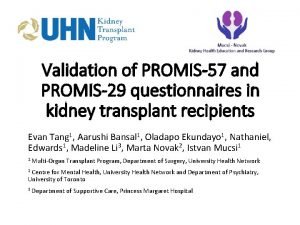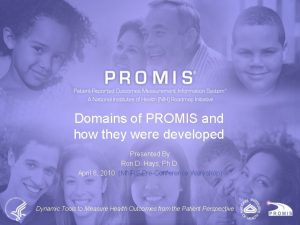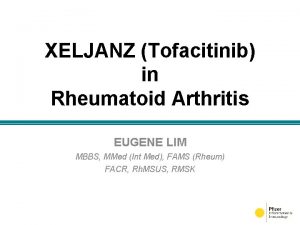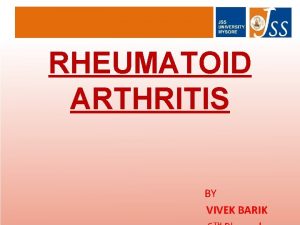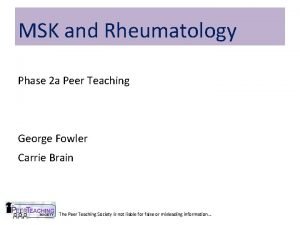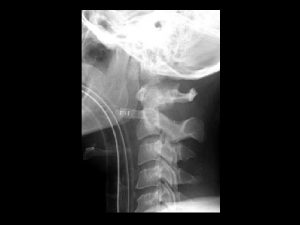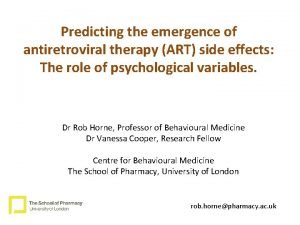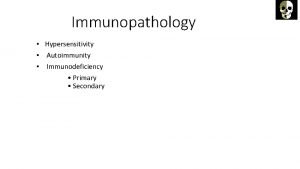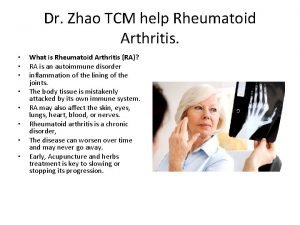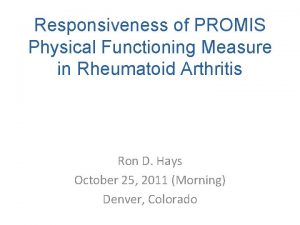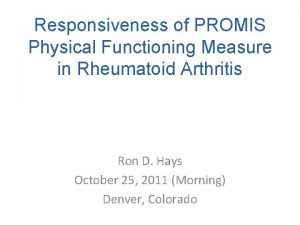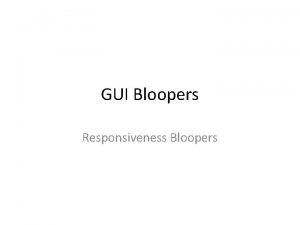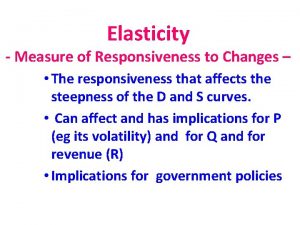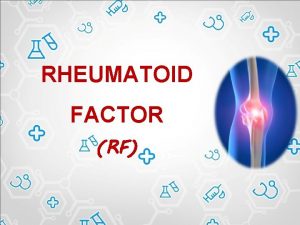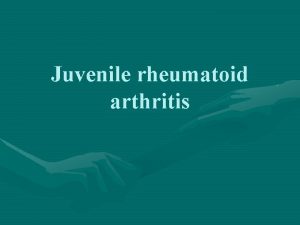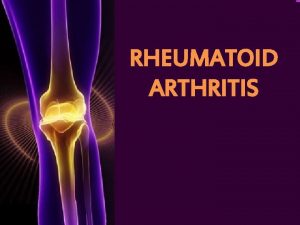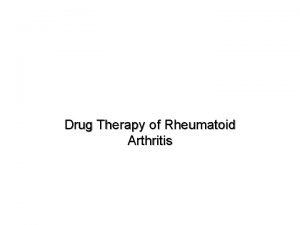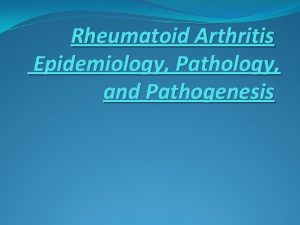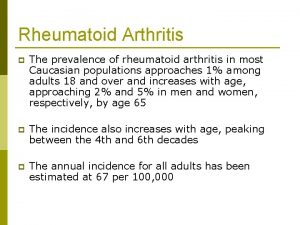Responsiveness of PROMIS Physical Functioning Measure in Rheumatoid

















- Slides: 17

Responsiveness of PROMIS Physical Functioning Measure in Rheumatoid Arthritis Ron D. Hays October 25, 2011 (Morning) Denver, Colorado

Future Issues • Bootstrapped SE for ES • Standardized response mean • More anchors in memo/future paper

Joan Broderick’s comment • about interpreting ES is supported by 2000 publication in Pharmacoeconomics. – “Researchers evaluating measures sometimes hail their virtues based solely on the magnitude of the HR-QOL score of differences without considering the size difference one should expect theoretically. A ‘bigger the better’ mentality is associated with a lack of hypotheses or theory about the underlying process. In a quest to show that an instrument is responsive to change over time, instrument developers may proclaim the validity of a HR-QOL measure because it changes over time, but fail to note that the degree of change should vary depending on whether the consequence of the intervention or perturbation in status is minor (e. g. getting bumped by a pedistrian) or major (e. g. getting hit by a truck). ”

Background

Background • One-year longitudinal observational study of 451 persons who met American College of Rheumatology criteria for RA – Baseline, 6 months and 12 months post-baseline • Designed to evaluate responsiveness of PROMIS “ 20”-item physical functioning short-form (“Are you able to wash your back? ” excluded). • Legacy measures – SF-36 Physical functioning scale and Health Assessment Questionnaire

Retrospective Rating of Change in Physical Activity We would like know about any changes in how you are feeling now compared to how you were feeling 6 months ago. How has your ability to carry out your everyday physical activities such as walking, climbing stairs, carrying groceries, or moving a chair changed – – – Got a lot better Got a little better Stayed the same Got a little worse Got a lot worse

Better Group We would like know about any changes in how you are feeling now compared to how you were feeling 6 months ago. How has your ability to carry out your everyday physical activities such as walking, climbing stairs, carrying groceries, or moving a chair changed – Got a lot better (n = 21) or a little better (35)

Worse Group We would like know about any changes in how you are feeling now compared to how you were feeling 6 months ago. How has your ability to carry out your everyday physical activities such as walking, climbing stairs, carrying groceries, or moving a chair changed – Got a lot worse (n = 30) or a little worse (n = 113)

Sample

Sample Characteristics % female % white Mean Age (range) Mean education (range) = 81% = 87% = 65 (20 -70+) = 14 years (1 -18)

Responsiveness Results

Effect Size By Measure Wave 3 – Wave 1 Wave 3 – Wave 2 12 Reported getting a lot or a little better (better) or a lot or a little worse (worse) on retrospective change anchor.

Prospective Change Effect Sizes by Anchor Change Subgroups Wave 3 - Wave 1 Better (n = 56) Worse (n = 143) PROMIS 0. 21 -0. 27 SF-36 0. 17 HAQ 0. 16 F Statistic Wave 3 - Wave 2 F Statistic Better (n = 55) Worse (n = 143) 30. 71 0. 31 -0. 17 23. 54 -0. 38 21. 43 0. 10 -0. 24 12. 49 -0. 23 15. 66 0. 24 -0. 11 13. 47 Wave 3 is 12 months after wave 1. Wave 2 is 6 months after wave 1. Better = got a lot better or a little better on anchor. Worse = got a lot worse or a little worse on anchor.

Prospective Change Effect Sizes by Anchor Change Subgroups Wave 3 – Wave 1 Wave 3 – Wave 2 Better Same Worse (n = 56) (n = 252) (n = 143) (n = 55) (n = 245) (n = 143) PROMIS 0. 21 0. 03 -0. 27 0. 31 0. 05 -0. 17 SF-36 0. 17 0. 04 -0. 38 0. 10 0. 07 -0. 24 HAQ 0. 16 0. 02 -0. 23 0. 24 0. 01 -0. 11


Change in PROMIS Physical Functioning Score by Anchor Change Subgroup Lot Better Little Better Same Little Worse Lot Worse (n = 21) (n = 35) (n = 252) (n = 113) (n = 30) Wave 3 – Wave 1 1. 94 a 1. 63 a, b 0. 27 b -1. 68 c -3. 20 d Wave 3 – Wave 2 3. 26 a 1. 96 a, b 0. 43 b, c -0. 82 c -3. 16 d

Questions? 17
 Promis-57
Promis-57 Promis domains
Promis domains Ai promis c-ai sa revii
Ai promis c-ai sa revii Ra factor range
Ra factor range Soft tissue rheumatoid arthritis
Soft tissue rheumatoid arthritis Pathology of rheumatoid arthritis
Pathology of rheumatoid arthritis Steinbrocker stage
Steinbrocker stage Swan neck deformity
Swan neck deformity Juvenile rheumatoid arthritis
Juvenile rheumatoid arthritis Rheumatoid arthritis side effects
Rheumatoid arthritis side effects Nursing care for rheumatoid arthritis
Nursing care for rheumatoid arthritis Rheumatoid arthritis
Rheumatoid arthritis Extra articular manifestations of rheumatoid arthritis
Extra articular manifestations of rheumatoid arthritis Nursing diagnosis for rheumatoid arthritis
Nursing diagnosis for rheumatoid arthritis Tofacitinib uveitis
Tofacitinib uveitis Rheumatoid arthritis
Rheumatoid arthritis Rheumatoid nodules
Rheumatoid nodules Difference between osteoarthritis and rheumatoid arthritis
Difference between osteoarthritis and rheumatoid arthritis
